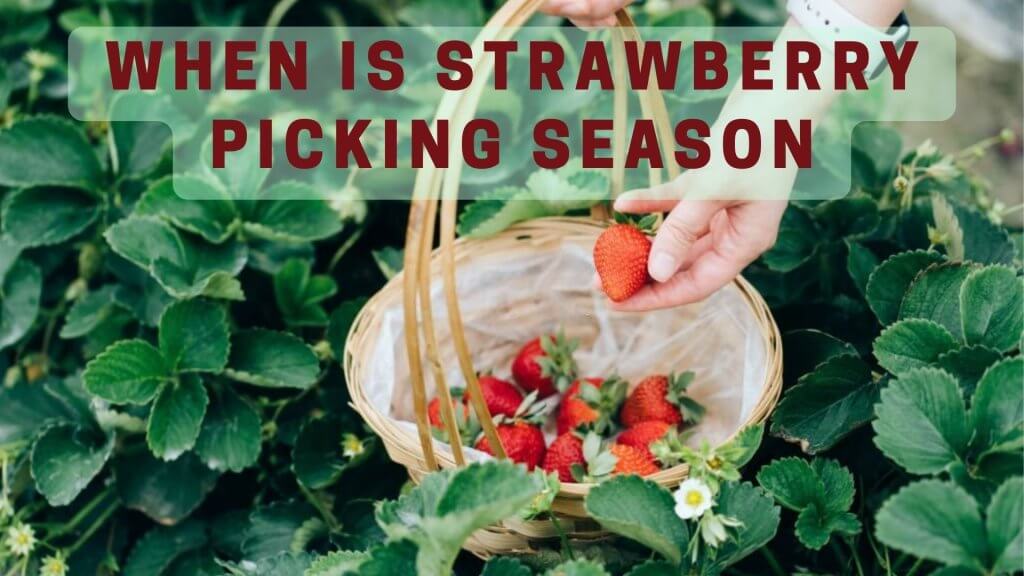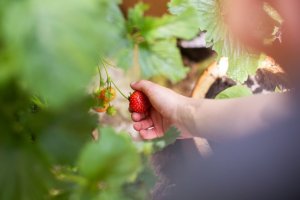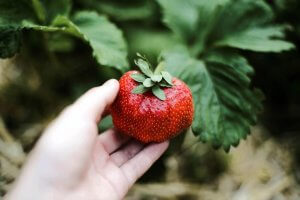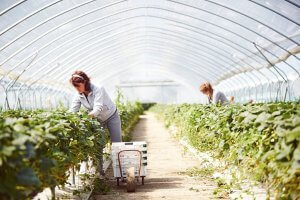
When Should You Go Strawberry Picking? When Is Strawberry Season?
As a general rule It is recommended to always inquire at your nearest U-Pick Strawberries operation before deciding to pick strawberries. There is a lot of variation in the time of harvesting based on the type of berry and what varieties are available for berry picking.
However, generally speaking those months in April, May and June are the months when the most strawberries are in season throughout the United States. The peak of the strawberry season is in April in some parts in Texas along with Florida.
In the remaining areas part of the South the peak of strawberries is in May. In the middle states the early June is the highest point of the strawberry season and for the more northwestern states as well as Canada the peak in harvest is later in June.
The timing of peak times also differs in each state and the weather can significantly influence production, too. Also, prior to going out to pick strawberries, contact the local farm.
The weather, the variety of strawberries planted, as well as the area which affect the strawberry farm and can influence when you are able to most efficiently pick strawberries.
In a specific way The time of day is also important based on what you will do with the fresh strawberries you have picked. If you intend to use them for eating immediately you can pick them anytime.
If they’re not going to be used for more than a few days then you should pick strawberries in the cooler portion of the morning , or during cloudy, more temperate days. Picking strawberries on sunny and hot days could cause them to soften and spoiling more quickly.
Why Should You Pick Your Own Strawberries?

It’s first informative and educational to meet those responsible for cultivating the food you consume. They also are knowledgeable about the plants they cultivate. In addition, they can inform you about their practices for growing.
Commercial strawberry farms usually take every step to maximize the amount of fruit they can sell to the market.
This is often the case when you use pesticides as well as anti-fungal chemicals in large amounts that leave huge residuals that you might not desire to consume. The manufacturers don’t list the residual pesticides, fungicides or any substances on label.
In fact, the strawberries that are commercially purchased from the market make the famous “dirty dozen” list each year. It is a list of the top 12 commonly consumed foods. Even after being washed, store-bought fruit can contain high levels of harmful chemicals on them and within the berries.
If you visit the local strawberry farm, you will be able to ask questions about the farming methods employed by the strawberry farm. In general, a local strawberryfarm employs lesser chemicals in the production of the strawberry plants andtherefore, produce “cleaner” strawberries.
Certain berry picking establishments are offering organically grown strawberry to pick this week! Another advantage that picking strawberries local is the fact that fruits tend to be more delicious.
Commercial companies do everything they can to boost the amount and size of strawberries grown. The smaller, more flavorful berries are taken away while bigger and more flavorless ones are shipped.
Picking Strawberries: Preparation
1. Call the Pick Your Own (or U-Pick Strawberries) Farm:

The individuals who oversee the operation ought to be able to inform you whether it’s worth your time and effort to go to this strawberry patch or not. The hours of operation are dependent on the availability of strawberries. Therefore, make sure you make a call prior to boarding the car to go out.
When you call, make sure to verify the availability of strawberries the hours of operation and strawberry picking directions, and the payment methods accepted. A lot of strawberry farms will only accept cash or checks therefore make sure that you select the correct payment method.
2. Take into Account Time Considerations:
Strawberry picking can be very time demanding, depending on the speed at which you pick strawberries and how many you plan to harvest. It typically takes between 10 and 15 minutes to locate and select a quart of fresh and ready-to-eat strawberries.
It can take as long as an hour to select the gallon. Naturally, if you have swift hands and plenty of strawberries available to pick this could take less time. Contacting your farmer can aid in determining the availability of strawberries and how long it takes to pick the number of strawberries you’ll need.
If time is short If you are short on time, many farms that allow you to pick your own strawberries also have pre-picked strawberries available to purchase by the pounds. A one quart of fresh strawberries will weigh approximately 1.5 pounds. Knowing the quantity of strawberries you require and how long it will take to select the ones that you want then you can decide on buying the excess.
Also, make sure you arrive as early as you can. In the height of strawberry season, a lot of people might be picking the strawberries, particularly during weekend. To ensure that you have the best strawberries, being early is essential.
If you are arriving at the end of the day on a weekend in the peak season, you could be looking out at fields of unripe berries.
3. Know Your Goals and Pick Strawberries Accordingly:
Before you going to pick strawberries, you need to understand what your goals are for strawberry picking. Determine how many strawberries you’ll use for making food and processing or eating fresh.
After you’ve determined the number of strawberries you’ll require, be careful not to pick strawberries over that number. Strawberries are known to have a very short “shelf-life” and will go rapidly bad. They quickly start to become moldy if stored at room temperature, and will only be edible for about 2 or 3 days when refrigerated.
4. Take Any Equipment You May Need While Picking Strawberries:
Most U-pick strawberries farms or pick-your-own strawberry farms provide suitable glass or plastic containers that are suitable for strawberry picking. However, they do typically charge for these containers. Therefore, if you wish to save money make sure you bring your own containers to store the strawberries you picked.
Any container can be used however, ensure that strawberries aren’t stacked up to the height of five inches. If you stack or pile the strawberries higher than that could cause bruising and damage to the fruit on the bottom of the stack.

The best containers are ones that are more rigid, like the plastic containers or the baking pans. Glad containers are great with metal cake or baking pans with sides of at least three inches in height. Pots are also a good option however they can weigh more to carry around when strawberry picking.
Because strawberries do not appear on the trees of our garden, they’re typically picked while sitting, squatting, bent over or kneeling. For those who sit or kneel the use of the knee pad or cushion for the garden could be beneficial also.
5. Plan for Good Strawberry Picking Weather:
I hope it’s sunny and warm while you are picking strawberries. Wear a hat and sunblock to ensure you don’t burn yourself and an hydration source so that you don’t dehydrate.
A bite or two of food might be an excellent option if you plan to go strawberry picking for a long duration. Bugs aren’t usually a huge issue, but if the weather was particularly rainy in recent days insect repellant could be an excellent option.
Choosing the Right Strawberries to Pick
When you are strawberry picking it is crucial to be aware of which strawberry to choose. It is crucial to select large and firm strawberries.
Be sure your strawberries have been red, too. In contrast to tomatoes and other fruits and vegetables strawberries stop maturing the moment that they are picked.
If you’ve ever thought about how to tell if a fruit is ready to eat All you need to do is examine the top of the strawberry. If the tips are completely red, then the strawberry is ready for eating.
Below is a picture of an illustration of the development process that a strawberry undergoes. The strawberry you pick should be fruit that are like those on the other side with no white tips and having the full, deep red color throughout.
How to Pick Strawberries
The best strawberry picking happens when the picker is able to apply the technical aspects of choosing strawberries with respect to the job to be completed. Here’s how to pick strawberries:
1. Keep the fruit’s stem at around one half of an inch higher than the berry with your thumb and index finger, while you hold the berry in your palm.
2. Cut off the stem and sever the stem by pressing it against your thumb, while rotating the stem.
3. Let strawberries (including the stem and cap) gently to fall into your palm. If you’re ambidextrous make use of your other hand for strawberry picking while you follow the same method.
4. Repeat step 3 until the palms are filled with strawberries.
5. Carefully place your handfuls freshly picked strawberries in your preferred container. Don’t crush the strawberries or stack them on top of five inches.
6. Repeat the whole process until you’ve reached your strawberry-picking goals or you are bored with picking strawberry.
Strawberry Picking Etiquitte
Before you decide to pick strawberries, it’s important to contact to verify the supply of the strawberries to pick, their hours of operation, and also the costs.
This will ensure that you and the farmer will be greeted with unpleasant surprises on your arrival. The most likely scenario is that there are children frolicking around, so dress accordingly.
If you are going to go strawberry picking, keep in mind that the U-pick strawberries farm is where farmers earn their livelihood. Be courteous. The plants could be killed or damaged when you walk on them, therefore be cautious not to step over the strawberry plants or the plants.
Be gentle around the strawberry plants and use a shrewd hands to distribute the leaves as you search for the strawberries. Be sure to select only fully ripe strawberries. Removing unripe strawberries is a way of ensuring that the farmer is liable for the loss. A mistake is part of the territory, however excessive inattention to detail could cause the farmer to lose a significant amount of money.
In addition, reduce the number of strawberries you consume when picking them or eating them while you pick is a request from the proprietor. It’s hard to stay away from eating a few attractive strawberries, however, be considerate and limit the freebies to the limit.
There’s no all-you-can-eat buffet. Also, strawberries aren’t snowballs. Avoid picking a fruit in a battle with your loved ones or your friends.
There is also the opportunity to assist the farmer by assisting him in the maintenance of the health of the strawberry fields. If you see damaged or partially eaten by insects take them off and put them in the middle of your row.
It is crucial to take the same precautions with any berries you find that are decayed scorched by sun or are ill. The farmer’s removal of these berries prevents rotting and other issues in the future from spreading to different varieties of strawberries. This helps make the strawberry picking experience much more enjoyable for everyone!
Care After Picking

When you return home After returning home, separate the fruits. Carefully pour the berries into shallow pans or onto tables. Discard any rotten or damaged strawberries, and then eat or throw away any that have been squashed.
When you are able put the remaining in a refrigerator and do not wash them. The washing of the strawberries should be done prior to eating or processing. Washing them accelerates the process of spoiling. Make sure you eat the strawberries that you have refrigerated within a few days or so. Then, they are sour, dull and colorless and will shrink and rot or become the color of a mold.
Conclusion
Congratulations! You are now able to pick strawberries. If you’re picking strawberries you are likely to be overwhelmed and choose excessively, despite warnings listed on this page.
This is acceptable! Utilize them to your advantage, if you’re frustrated, make new recipes using the measurements and conversions for strawberries mentioned above. If you’re courageous enough, you can purchase strawberry plants and start growing strawberries your self next year!



